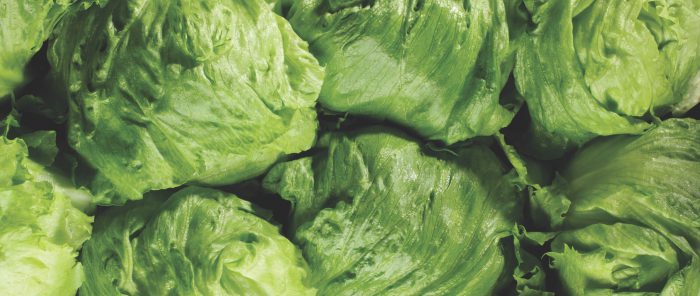
Rinse lettuce under running water while using clean hands to gently rub the leaves. Wash hands with soap and water before and after handling lettuce. coli and salmonella, making proper handling essential. Lettuce is a vehicle for foodborne pathogens, particularly norovirus, E.

Avoid freezing iceberg lettuce, as ice crystals may form due to the high water content, resulting in a slimy texture when thawed. Unopen bagged lettuce lasts three to five days after the date on the bag after opening, lettuce lasts about two days. Individual leaves should be dried, bagged and placed in a crisper drawer, if available. Whole heads can be wrapped in a paper towel, then stored in a plastic bag for one to two weeks. Once you get it home, refrigerate iceberg immediately. To maintain color and prevent wilting, store iceberg lettuce away from high ethylene-emitting produce such as apples, melons and pears. Lettuce is temperature-sensitive and best stored between 32 to 35 degrees Fahrenheit. Freshly shredded iceberg lettuce is sold in packs of five-pound bags. For foodservice, cases of 24 heads of iceberg lettuce and cartons of 12, 18 and 30 heads are sold by some wholesale retailers. In Quantity: To extend shelf life, iceberg lettuce should be harvested whole, minimally processed and swiftly transported. Like parsley, celery and chamomile, iceberg lettuce contains apigenin, a flavone touted for its potential health-promoting, disease-preventing benefits. At 96% water and only 10 calories per cup, iceberg adds satiating bulk to a meal, and its delicate flavor serves as a gateway vegetable for selective eaters. Darker greens may pack a greater nutrient punch, but 2 cups of shredded iceberg is an excellent source of vitamin K and a good source of folate. In the Clinic: The notion that iceberg lettuce lacks nutrition is false. The result is soft and charred on the outside with a crisp interior. If sliced into wedges, iceberg’s fibrous leaves will hold their shape. Grilling or roasting in the oven unleashes caramel notes. Iceberg is done when it’s wilted with a slight crunch. Lettuce cooks fast, so keep a close eye on the pan. Sauté chopped lettuce leaves with garlic, soy sauce or vinegar.

Honor the original salad by focusing on quality ingredients or reinvent it with salty upgrades like sardines or capers. The iconic wedge salad - quartered iceberg topped with blue cheese, bacon bits and diced tomatoes - remains a chophouse staple, turning humble lettuce into decadence.

For textural variety, mix iceberg with softer cultivars like loose-leaf or butterhead, or with greens such as spinach or arugula for a peppery bite. In the Kitchen: A bed of iceberg is a blank slate, ready to deliver a desirable crunch. Best growing temperatures are 60 to 70 degrees Fahrenheit, making spring or autumn ideal in most climates. Heat puts lettuce at risk of bolting, or rapidly producing flowers and seeds while abandoning leaf growth. Lettuce has a shallow root system, so successful cultivation requires light, frequent watering. The green exterior gradually lightens toward the center, transitioning from green to pale yellow to nearly white. Mature iceberg leaves can grow to be a foot in diameter. The leaves of iceberg are arranged in dense rosettes, similar to cabbage, and have a neutral, watery flavor. Frozen chunks of ice, tiny “icebergs,” kept it fresh. Before refrigerated train cars existed, the vegetable was carefully packed in ice that melted during transport. But iceberg’s durability was advantageous for travel. Before refrigeration was common, lettuce’s notoriously short shelf life made commercial production a challenge. Developed in 1894 by horticulturists at the Burpee Seed Company, iceberg lettuce experienced a rise in popularity in the 1940s. Often overshadowed and rarely undressed, iceberg boasts a meek and mild taste that, when creatively paired with key ingredients, elevates a meal and proves to be anything but bland.Īlso known as crisphead, iceberg is a type of head lettuce and has been rated the fifth-most consumed vegetable in the United States.


 0 kommentar(er)
0 kommentar(er)
